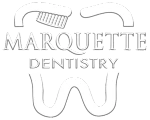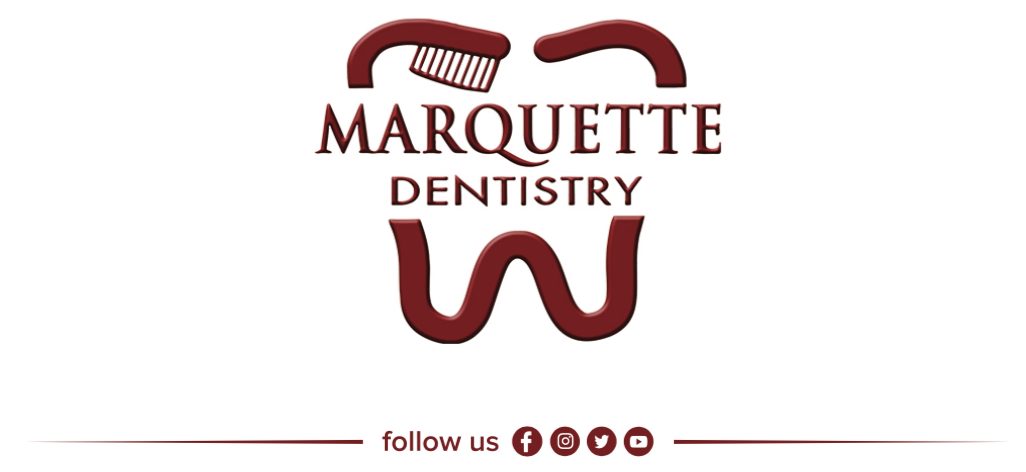Prevention is always better than treatment. Here at Marquette Dentistry, we believe that prevention is a major key factor in having a healthy smile. By actively preventing disease and decay through regular home care, professional dental cleanings, and regular exams, you will maintain a healthy, beautiful smile.
- Professional Cleanings
- Dental Examinations
- Home Care
- Sealants
- Digital X-Rays
- Gum Disease
Professional Cleanings
Professional cleanings (dental prophylaxis) performed by a certified dental hygienist form the foundation for preventing gum disease and tooth decay. In a professional cleaning, your hygienist will:
- Remove plaque from the teeth – Plaque is a sticky substance that forms in the mouth from food, saliva, and bacteria. Plaque sticks to teeth and causes tooth decay and gum disease.
- Remove calculus (tartar) above the gum line – Calculus is a plaque that has hardened on the tooth surface and is difficult to remove. (Calculus below the gum line indicates gum disease and requires a different procedure to remove it.)
- Polish and remove stains from teeth
Dental Examinations
Often, people do not understand the importance of dental examinations and want to skip this step. However, dental examinations help to diagnose the disease before it becomes hazardous to your health. In addition, regular examinations can save you money by alleviating problems while they are small and before they become expensive to repair, or in some cases, impossible to repair. Your dental examinations generally include the following:
- Oral cancer screening
- Gum disease evaluation
- Visual examination of tooth decay
- Examination of diagnostic x-rays to see cysts, tumors, invisible decay and other problems that can’t be seen by the naked eye
- Evaluation of status of current restorations (fillings and others)
We cannot express enough how important it is to see your dentist regularly. Remember, preventing disease is always better than treating disease.
Home Care
Having a healthy, beautiful smile all starts at home. Adequate home care is imperative if you want to maintain a healthy, beautiful smile and prevent costly dental treatment in the future. Overall, the goal of home care is to regularly remove the sticky film of bacteria called plaque from your teeth.
Brushing
Brush, Brush, Brush. It is important that you brush your teeth twice daily using a soft toothbrush that is ADA approved. We also recommend modern electric toothbrushes such as Sonicare and Braun. Gently vibrate the brush in a circular fashion at a 45-degree angle to the gum line. Then gently vibrate the brush back and forth on each tooth surface until you have effectively cleaned the entire mouth. Did you know that bad breath is often caused by the bacteria on our tongues? To prevent this you should also brush your tongue to remove the bacteria that cause bad breath.
Flossing
Are you someone that regularly overlooks the importance of flossing? Perhaps you believe that flossing your teeth is not an important step. However, flossing is incredibly crucial to maintaining a healthy smile. We recommend that you floss daily to remove plaque between teeth that you can’t reach with regular brushing. Take 12″ to 18″ of dental floss and wrap it around the middle finger of each hand. Pull the floss tightly, and then use your thumb and forefingers to slide the floss gently between each set of teeth. Curve the floss around each tooth and move the floss up and down along the tooth. Going as low as you can comfortably get under the gum line. Use a fresh section of floss for each tooth until you have flossed the entire mouth.
Rinsing
Always rinse thoroughly with water after brushing (or after meals if you are unable to brush.) You may occasionally use mouthwash to rinse. However, recent studies indicate that the over-use of mouthwash in an otherwise healthy mouth can change the normal biological activity of the mouth. Therefore, leading to dried tissues and other problems.
Sealants
Have you been worried about your teeth decaying over time? Unfortunately, this is something that can happen to many people. However, you are able to protect the chewing surface of teeth from decay with the help of sealants.
The Problem:
- Protect normal pits and grooves on the chewing surface of back teeth
- Stop small amounts of decay from growing larger
The Solution:
Normal pits and grooves on the chewing surfaces of back teeth can trap food that can’t be removed by brushing or washed out by water or saliva. A sealant is a tough, plastic material designed to bond (stick) to tooth enamel. These clear or tooth-colored sealants are painted onto the tooth surface to “seal” the pits and grooves and protect against decay. Overall, they are generally applied to children’s first permanent back teeth. However, they can also be useful for adults in certain situations.
Advantages:
Sealants are an excellent way to protect the chewing surfaces of teeth from decay. They are considered a great preventive measure for decay. Overall, sealants are a much better financial investment than treating decay after it has started.
Disadvantages:
Sealants are not permanent. They generally last about five years with normal wear but can wear off or chip off earlier in certain instances. Also, sealants do not prevent decay between teeth or the onset of gum disease. So regular home care and dental visits are important.
Alternatives:
There are no appropriate alternatives to sealants. If a tooth has decay, it will need a filling or other restoration.
Digital X-Rays
How do x-rays help?
Dental x-rays or radiographs are very important. They allow the dentist to detect problems that cannot be seen by the naked eye. These items include loss of bone supporting the teeth (periodontal disease), cysts (sacks of fluid that form on the roots of teeth), cancerous and non-cancerous tumors, decay that occurs between teeth, and the location of teeth that haven’t yet erupted into the mouth.
By using an x-ray to make certain no pathology is present, we can help save you time, expense, pain, and money by possibly avoiding additional treatments. In some cases, when dental x-rays show the location of tumorous growths, x-rays can be responsible for saving your life.
Are dental x-rays safe?
We use the most modern x-ray technology available today. Because our x-ray machines are digital, your radiation exposure is reduced by about 90 percent! The amount of radiation exposure your body receives on an airplane flight from Los Angeles to New York exceeds the amount of exposure you receive from a conventional, not digital, dental x-ray machine. Contrast this minimal exposure with the risk of not finding a problem until it has become serious. As a result, you can see why we prescribe preventive diagnostic x-rays.
Gum Disease
Did you know that gum disease (Periodontal Disease) is responsible for about 70 percent of adult tooth loss? It is characterized by swollen, inflamed gums surrounding the teeth. Plaque, a sticky substance that forms in the mouth from food, saliva and bacteria gets inside the space between the gum line and the tooth. If not removed, plaque hardens into a substance called calculus or tarter that is very difficult to remove. Eventually, the bacteria in the plaque and tarter eat away at the fibers that hold the gums to the teeth, creating deep pockets. As bacteria spread, the pockets become deeper. Until the bacteria finally eat away the bone that holds the tooth in place.
Gum disease is diagnosed through a process that measures the depth of the pockets around each tooth. Pockets that are greater than 3 millimeters in depth are considered hazardous. Therefore, will generally require treatment.
How is gum disease treated?
Gum disease is treated by carefully removing the bacteria and substances that form in the pockets around the teeth. The removal of this material occurs on a microscopic level and requires great skill. Our dental team has had advanced training regarding how to effectively remove all of the bacteria.
This process of removing the bacteria usually requires several visits to our office. Once the bacteria have been removed, the pockets must be cleaned and maintained on a regular basis by a certified dental hygienist. Otherwise, the bacteria will return.
Rehabilitative Treatment
Occasionally, due to trauma or disease, people will lose teeth that cannot be replaced. In this case, rehabilitative dental treatment is a must.
Are you someone that is lacking confidence due to having several missing teeth? Missing teeth can create many new problems besides just a lack of confidence and an unattractive look. It creates problems including bone loss, shifting of other teeth, and bite problems. As a result, each of these new problems can, in turn, affect other areas of your dental health. Overall, creating a dangerous downward spiral. So replacing that missing tooth or teeth with a natural-looking alternative can greatly help improve a person’s self-image and confidence.
In this section, we will look at two of the best ways to replace missing teeth: cosmetic dentures and dental implants.
The Problem:
- Some or all of the teeth are missing
- The inability to chew well
- An unattractive smile
- Less youthful appearance: cheeks sinking in, lips thinning, chin jutting out
- The shifting of teeth resulting in bite problems
- Increased stress on the remaining teeth
Traditional Dentures
A traditional denture is a removable replacement for missing teeth and adjacent tissues. It is made of acrylic resin. Sometimes in combination with various metals. Complete dentures replace all the teeth in a jaw and fit directly on the gums and supporting bone. Partial dentures fill in the spaces created by missing teeth. Resting partly on the gums and partly on the remaining teeth.
Dentures are not attached to anything and simply rest on the gums. Because of this, the denture can get dislodged when chewing and often limits the realistic selection of food choices for the denture wearer.
Dentures and Implants
Fortunately, dentures can be attached to implants to help improve their fit and greatly increase chewing ability. As an added benefit, the implants prevent the steady bone loss caused by traditional dentures.
Dentures attached to implants give support to the cheeks and lips creating a more youthful appearance. Speaking, chewing, swallowing and smiling are also improved due to the confidence that stems from having the dentures firmly secured in the mouth.
Disadvantages:
Dentures attached to implants must still be removed for cleaning. And, although they are much more secure than traditional dentures, they may break loose when chewing especially sticky food. Implant dentures may also cause some chafing and discomfort, however, because they are held firmly in position, they do not cause the level of chafing and soreness of traditional denture.

